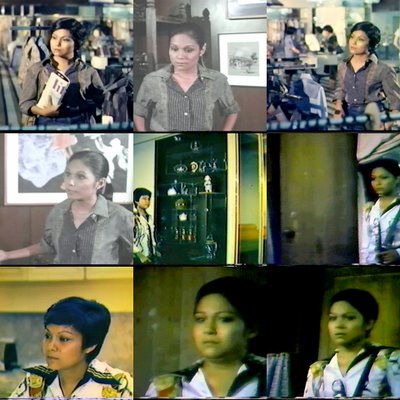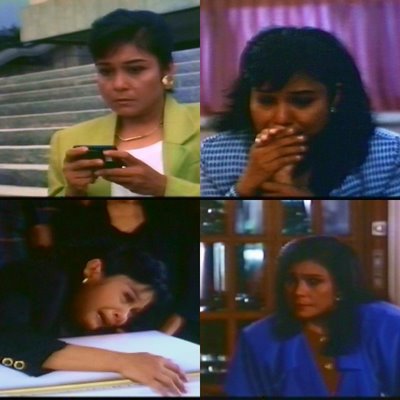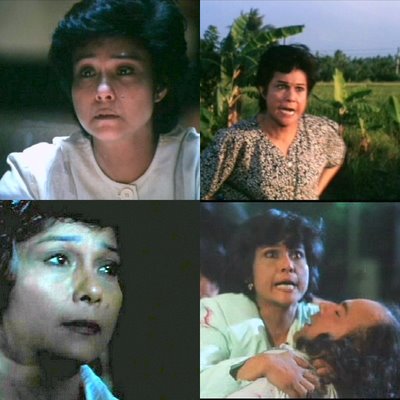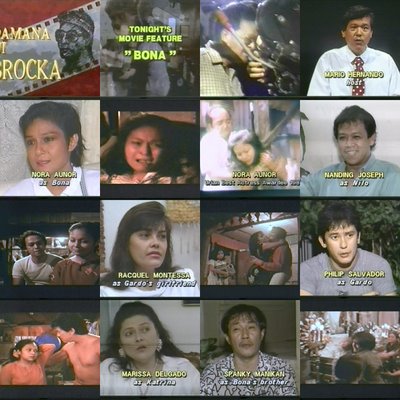BONA: Martyr Or MonsterFilm Review By: Noel Vera
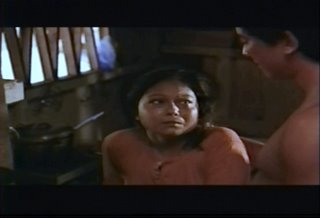
(Please note: plot discussed in close detail)
Lino Brocka's Bona is possibly the least-seen of his major works, partly because the two remaining good prints of the picture had been squirreled away abroad (to the Cinematheque Francais and the New York Metropolitan Museum of Art), while Filipinos back home had to content themselves with fading recollections and equally faded Betamax tapes. Everyone remembers how powerful the film was; no one can rightly say they've actually seen it, at least in recent years.
It's exciting news to learn that Cinema One with the help of the Cinematheque is broadcasting a clear new video copy of Bona , one with French subtitles. For a new generation of viewers--one barely able to recognize the name of Brocka--this is a chance to finally see a famed classic; for those who remember the film from its Metro Manila Film Festival run this is a chance to update (and possibly destroy--but that's the risk of any revival) their Beta-assisted memories with freshly minted images. Whichever you are, veteran or innocent, even twenty-six years later there's much in the film that can still shock and appall.
To know more about Bona the film it's helpful to know a little about "Bona," the episode that debuted on the TV drama anthology Babae (Woman), with Laurice Guillen as Bona and Ronaldo Valdez as the actor she has an affair with. Brocka in a 1981 interview with Agustin Sotto describes the TV drama as a "first love affair" that the girl enjoyed so much she starts following the man around; the film on the other hand is "a case study of a social phenomenon…an 18-year-old girl who gives up everything--her boyfriend, her family--for her movie idol."[1] Guillen, the actress who Brocka called his "Jeanne Moreau" (meaning, presumably, that she would play the neurotic types) said she could "relate to it…like Bona, I felt so exploited in what I felt was a one-sided relationship."[2]
Translating the drama to the big screen, Brocka made some fundamental and quite fascinating changes--the casting of Nora, for one, as Bona. Aunor, famous for being the first Filipina actress with brown skin and small stature to become a movie star, is equally famous for playing countryside maidens, domestic helpers, laundry women, water carriers--humble figures her millions of fans could identify with, and whose eventual rise to fame and fortune they could celebrate. The course of Bona's fate runs backwards--she's the daughter of a middle-class family. If she shines shoes and cooks food and cleans house, it's because she chooses to; she elects to leave her family and humble herself for her movie idol. As Brocka put it, referring to Aunor's own fans: "You will hear them talk about what they have given up. Some have given up their husbands, others a good job…this sacrifice becomes a badge for them."[3]
Of Aunor's stardom Brocka said, "She was the only star I know who could silence a crowd. After the premiere of Ina Ka ng Anak Mo (You Are the Mother of Your Child, 1979), a big crowd waited for her outside the lobby. People were unruly. Her car was being bumped by the crowd. All she did was put a finger on her lips and raise her right hand, and it was like the parting of the Red Sea. You could hear a pin drop." [4] It's typical of Brocka's sensationalist genius, not to mention his sense of mischief, that he take the inspiration for such fanaticism and make her play someone capable of the same fanaticism; when the fans sat down to watch their heroine, this time they found themselves in the shoes of an altogether darker character, capable of extremes of cruelty and violence, a warped reflection of themselves.
The opening sequence, filmed during the Feast of the Black Nazarene in Quiapo, Manila, right away establishes the similarity between movie-star worship and religious worship. Brocka's camera is poised from high up--from a godlike vantage point--looking down on the sea of faces surrounding the statue; he captures footage of men and women tossing towels at the statue, hoping attendants will pick up the towels, touch the Nazarene and toss it back to them (the dark wooden statue is said to have miraculous powers). The sequence has the crudity of a documentary, or a news segment, and seems all the more real for it. At a certain point, the camera catches Bona watching the parade go by; a cut and Bona is in the same pose but her hair is different--she's at a studio shoot, facing a different idol for adoration.
Early on Brocka establishes how lowly Gardo, Bona's movie actor, is. Gardo is a bit player who has dabbled in everything from song-and-dance to softcore porn, all with little success. Fans complained about having Aunor's character admire such a small-time loser, but Brocka points out that "if she had been adoring a superstar like herself, she would be surrounded by so many fans that her own personal drama would be obscured…" [5] More, a multitude of fans would imply a support group, other people sharing in her fixation, lessening the burden of loneliness and alienation from the world. Bona's choice of worship isn't all that unusual, actually--Adele Hugo in Francois Truffaut's L'Histoire d'Adele H. attached herself to a junior officer, to his and her mutual ruin; Catherine Sloper was ready to give up everything for her low-life paramour in Henry James' Washington Square. With certain pathological types the object of obsession's impeccability matters less than the invincibility of said obsession.
Gardo as played by Philip Salvador is a vain, self-centered, immature man; he's also a drunkard, a womanizer, a brawler, and a braggart. When Bona moves in with him he accepts her services eagerly, when she makes the slightest complaint he slaps her, and when she poses the least inconvenience he tosses her aside--not once, but twice. When Gardo takes advantage of Bona's willingness to serve him hand and foot he does with all the careless eagerness of a child, voice and face cheerful as if he were saying: "Isn't this fun? Don't you wish we could always be like this?" What's so fascinating about Brocka's direction of Salvador is Brocka's willingness to "play into type"--to show Gardo's character embodying not just every cliché about narcissistic actors, but also every unflattering gossip said against Salvador himself. Brocka either flirts dangerously with the rumors or simply doesn't care who notices: he poses Salvador in various stages of undress against light and shadow, the better to show off his smooth muscles and noble profile. Ronaldo Valdez, who originated the role in television, is an excellent enough actor that he can play a handsome cad and still be charming, even worthy of our sympathy (as he does to wonderful effect in Brocka's 1976 Insiang), but Valdez also gives off a powerful macho vibe--he's like a Filipino Clark Gable constantly on the prowl. Salvador as he appears in the film version is prettier, more delicate, a petulant child in need of care--care that Bona is willing to give Gardo in terms of the film's story, and Brocka is willing to give Salvador in terms of the film's making. The parallels between Gardo and Salvador, between Bona and Brocka (even their names sound similar) are unavoidable.
It's a hideously unsparing portrait and Salvador must be given his due for agreeing to play such a character; he must have had some idea of how people would react and how closely they would compare his real self to his reel self, yet there he is on the big screen, giving himself over completely to the role. Salvador is not a skilled actor--I think some of his best performances came about mainly because Brocka takes such extraordinary care of him--but here he achieves the honesty of a confessional, of self-revelation. His vanities and insecurities as an actor come pouring out of him as if through hypnotic therapy (onscreen they are passed off as drunken tirades); his neediness--his greed for constant attention, approval, adoration--is so great any possibility of admiring the man is swept aside by an overwhelming sense of contempt. What intensifies this quality in the performance is the sense you have that Brocka is confessing as well, admitting his foolishness in being so utterly taken in by a pretty face; you might say that this film is his way of seeking maybe not revenge, but resolution.
Which brings us to Aunor, and if Salvador is an actor by director's fiat (careful choice of appropriate roles, even more careful framing and lighting of the actor for maximum beauty and dramatic impact) Aunor is an actress almost despite the director. Brocka uses the opposite approach with her that he uses on Salvador--no glamour shots with thick gels or careful lighting, no easy scenes with paint-by-numbers emotions. Brocka uses long takes for crucial moments and in those takes she's often the focus, the fulcrum, around which the scene's complicated emotional scheme turns; even when her fellow actor looms larger on the screen, or is favored by the camera's position, she dominates the scene.
The story is familiar to most Filipinos, and for those not familiar, it's easy enough to follow: Bona attends Gardo's shoots, often bringing him soda and a snack (at one point we see the origin of Bona's fixation--an autographed picture of Gardo that he in all probability wished he never gave her). One night she is accompanying Gardo when he is beaten up; she takes him to his house and nurses him back to health. When she returns home she's whipped by her father (Venchito Galvez) for disappearing without a word; she leaves her family and informs Gardo she's moving in with him. Bona does everything for Gardo--the cooking, the cleaning, the fetching of water (a detail which must have tickled fans--Aunor was a water seller in the province of Iriga before she became famous); she even sells bottles in a cart for housekeeping money, and asks for credit from the grocery when money is short.
Early on Brocka establishes the crucial scene where Bona has to boil water and mix it with tap water for Gardo to bathe in; the image--a grown man washed by a grown woman--inspires thoughts of infantilism. Recall that after Gardo had been beaten he had looked up at Bona and, delirious, mistaken her for his mother; on several other occasions when Bona tucks him into bed drunk he talks to her as if she was his mother, speaking in a slurred, petulant voice. Gardo with Bona often regresses into a childlike state where he demands to be pampered and spoiled; Bona, being fixated on Gardo, readily agrees to his demands.
It's an oddly chaste situation--odd especially as Laurice Guillen in the TV version lost her virginity to Valdez right off--and all the more authentically perverse for its chastity. An infant is a sexual being, but the sexuality is focused more on the skin (warm bathing water) and mouth (food, drink) than on the genitals (undeveloped in a baby). This film's Bona, presumably a virgin, would know little about genital sex; she readily fulfills Gardo's demands for food and warm water, but is helpless when it comes to his two fiercest needs--for strong drink (which he slakes at the nearest nightclub bar) and for adult sex (which he sates through practically every pretty woman he meets).
Midway through Brocka gives us a shot of a fully awake and standing Gardo looking down on Bona, asleep under the mosquito net; this reversal is so startling we see it instantly for what it is: Gardo has finally come to see Bona as a sexual being. It isn't a complete reversal, of course; this still has to be all about Gardo and his pleasures. He wakes Bona and demands to be massaged; presumably he believes that the experience of spreading oil onto his naked body will be enough to arouse Bona, convince her to give in to him.
He grabs her by the wrist. Brocka cuts to a shot of Bona's face, and the expression is strangely familiar--it's the same expression Aunor had with Lito Lapid in Mario O'Hara's Kastilyong Buhangin (Castle of Sand, 1980), an expression she wears when some needy man comes to her, asking for sex. It's the expression of a woman wise not in matters sexual, but in the ways of the world and of her own body as she debates with herself: "making love to this man is not the smart thing to do…but I'm tired of always knowing the smart thing to do (or, in Bona's case "tired of not knowing what to do"). In any case, I want to do this."
The punchline comes the next morning, when Bona prepares Gardo's breakfast. Bona is guarded, wary, alert for any change to come over Gardo. Nothing--he's his usual cheerfully self-absorbed self. Gardo has gotten away with it again; Bona for all her intelligence has outsmarted herself, given away what most Filipinas consider their most valuable asset--their virtue--for practically nothing.
Or has she? More on that thought later…
Brocka is a master at sketching social hierarchies, and Bona contains fine examples of his skill. Bona, constantly following in Gardo's wake, meets the different people in his life, and constantly tests herself against them--establishing pecking order, in effect. When Bona sees Gardo and a woman walk into a motel room, the next day Bona shoves the woman into water; when Gardo brings a woman home for the night, the next day Bona chases the woman out with a broom--and is promptly slapped down by Gardo, who informs her that he'll bring home anyone he chooses. Order established--the girlfriends, then Bona, then Gardo above all. When she meets Nilo (Nanding Josef), who is clearly in love with her, she feels nothing but contempt--in the scene where Nilo confesses his love for Bona, Brocka frames the two with Nilo behind Bona, and Bona refusing to look at his face. As far as Bona's concerned, Nilo occupies the ladder rung below her--the only possible position for someone foolish enough to love unreservedly (someone, in effect, much like herself).
Interestingly, Nilo is the only one who is able to free himself from Bona's influence (more on this later): taking Bona's advice to heart about seeking other women, he informs her (in a scene where they stand side-by-side, Nilo's bulk overshadowing Bona's slight build within the camera frame) that he's getting married. It's an odd moment: Bona seems to acknowledge Nilo's risen status by confiding a dream she has, an eerie apocalyptic dream where everyone is burning, and she is wrapped in fire. Brocka makes no attempt to visualize the dream, but he does wrap Aunor in the orange glow of a Manila Bay sunset.
Bona's relationship with her family is a thornier issue: she loves her mother and her mother loves her; that much we know. Her mother makes demands at first ("Come back now, and forget Gardo"), qualifies them ("Come back anytime, but you must forget Gardo"), eventually finds her power to compel her daughter home taken almost completely out of her hands ("Come back, but don't let your older brother (Spanky Manikan) see you, or he'll kill you."). The father throws Bona out, finds out where she's staying, attempts to drag her back home; Bona tries to defy him both times, but only the second time does she succeed, and only thanks to a plot twist (a heart attack, conveniently timed--or was it?).
Now is as good a time as any to note the contribution of the great Conrado Baltazar, who gave films like Insiang (1976) and Jaguar (1979) their inimitably squalid look, and Tatlong Taong Walang Diyos (Three Years Without God, 1976) its at times stylized lyricism. Baltazar gets deeper shadows and harsher glares out of an incandescent bulb (the lighting of choice of Manila squatter shanties in the '70s) than almost any other cinematographer I can think of; he knows how to bring out the muddy details of a sewage-choked canal or a trash-strewn street so that you can practically smell the stench. Brocka, trusting in Baltazar to achieve what he needs, focuses on the blocking and performances of his actors. The words "stagy" and "theaterbound" often have unflattering connotations, but Brocka uses his theater training to locate his actors effectively within the frame, in a way that develops his "pecking order" theme--who is dominant, who is submissive, whose status is ascending, whose is descending. Within Brocka's trademark long takes--the theater proscenium translated to the big screen--you can feel the crisscrossing lines of force as actors enter, struggle, and--win or lose--resolve their conflict.
Or you hear the terrible hiss of energy dissipating, as in the shot where Bona follows Gardo and one of his girlfriends out a bar's back door. The camera pans from bar to nearby motel; Gardo and his girl don't even hesitate--they walk through the motel room door and shut it behind them. Bona is left in the parking lot staring at the door, disco music playing behind her; after a long while you see her climb into a nearby jeep (decorated with the film crew's wrap party banner), presumably to wait out the night, maybe sleep. The pathos of the scene, the unutterable loneliness suggested by Bona's silent back as she faces that door is something few other filmmakers can surpass; I doubt if Brocka ever did, himself.
Often the conflict isn't resolved, or is resolved in a way that achieves only a temporary balance, the hidden instability increasing with time. Crucial to emphasizing this element is Max Jocson's music, particularly his bongo drums. I wondered about those drums and their thrilling tattoo at first, how appropriate they were to what is essentially a melodrama (they sounded like they belonged in an action picture); after awhile my doubts vanished. Jocson's drums signal the presence of tension, of a huge watch-spring being turned round and round until it couldn't possibly be tighter: you waited for the spring either to quickly unwind or to snap, with the resulting catastrophic consequences.
As to the catastrophe's catalyst--much has been written about Gardo's selfishness towards Bona, the wretched way he treats her; I have yet to read anyone mention Bona's effect on Gardo. Bona's devotions hold Gardo back, keep him regressed and childish; while Bona caters to him, Gardo will not learn how to care for himself (one wonders how he managed before he met Bona), he will not control his drinking or womanizing (both of which continually land him in trouble), he will not move beyond the illusion that he is an aspiring star waiting for his big break. Gardo is in a state of stasis; he will not grow up, he does not want to grow up as long as he remains in Bona's heroically patient care.
Enter Katrina (Marissa Delgado, one of Brocka's regular stock players). She is a woman's woman whose figure has developed far beyond Bona's childlike physique. Gardo is in love with her, and she with him; better still, she has money. Gardo and Katrina wake Bona up late one night: he has a gift for her--a birthday gift! Bona sits up, eyes heavy with sleep, but you can tell she is wary--Gardo receives gifts, he never gives them (Gardo says Katrina chose the gift; presumably, she used her own cash to buy it). Gardo insists that they go out; at the nightclub the camera looks straight at Bona while she peers at Katrina and Gardo on either side of the screen, dancing. She has her hair pulled back, and she's wearing Gardo's gift--a v-cut purple blouse that fits her simplicity perfectly. It's the rare moment where Bona finally manages to look lovely (and Brocka privileges her with a glamour shot), but no one's paying attention; Gardo and Katrina only have eyes for each other.
Later, Gardo, sitting at the kitchen table, gives her the news: he's giving up acting--he loves it but apparently the job doesn't love him; more, he and Katrina are immigrating to America, and Bona has to vacate and go home because he's selling the house. Bona has just come from her father's funeral, where she had been thrown out by her furious elder brother. She has never looked lovelier than she does now, standing at the far wall wearing shoulder-length hair and the dress she had on at the funeral; she has also never looked more threatened. She walks up to Gardo's table (walking up to the camera lens), informs him that her brother threatened to kill her if she ever comes back, and asks what is to become of her. Gardo, thoughtless as usual, has no real answer--a foreground object (he occupies the left side of the screen) with no force, no presence, no ability to resolve the conflict being presented to him. In his mind he's already looking forward to life with Katrina in the United States; Bona is just an annoying unresolved issue here in Manila.
We're not paying attention to Gardo of course; our eyes are fixed on Bona, who says nothing yet is clearly devastated. It's Brocka's cleverest bit of misdirection, I think: by focusing on Bona's anguish we are distracted from a crucial development in Gardo's life--his attainment of a certain kind of maturity, a certain kind of belated adulthood. Katrina has managed to prod Gardo into thinking of others, however briefly (Bona's birthday gift); has helped him realize he must give up useless pursuits (becoming a movie star); has redirected his energies into something ostensibly more productive (immigrating to America).
Why is Katrina's influence so positive and Bona's so negative? Isn't Bona supposed to be the heroine of this film? Looking back, one wonders just how much control Gardo had all along--control which, when you think about it, is actually a function of how much control Bona allowed him to have over herself. You wonder about Bona's wariness the morning after she was deflowered; was she looking for affection from Gardo, some sign from him that he finally regards her as a woman, to be treasured and desired? Or was she looking for signs of change--signs of Gardo's attitude towards her evolving, becoming less childlike, moving away from the stasis she so dearly prized? Was his indifference to what happened the night before a source of disappointment for her, or relief?
With her family it seemed that stronger forces bent Bona this way and that, but when you really think about it, you realize that even then everything was shaped by Bona's decisions--she manages to stay with Gardo and her defiance triggers her father's heart attack. She may be terrified of her older brother but his authority is strictly limited--outside of the house he, unlike their father (who suffers as a consequence), does not try to reach out and pull Bona away from Gardo.
As for Nilo--Nilo seems to be the exception that proves the film's "rules." He loved Bona, but found love elsewhere when she rejected him. Unlike the others, Nilo is willing to adjust, to compromise, and this flexible attitude saves him; you might say of all the characters he's most immune to Bona's "curse."
So--does Bona deserve a radical re-evaluation? Is Bona the real villainess and Gardo her helpless victim? Not necessarily--I still think Gardo is basically selfish and Bona essentially pathetic. But the flow of feeling from people who give and people who take is rarely simple, and never one-way; there is feedback, a series of transactions, interesting vortices of emotions at play here that make the film much more than just a sordid portrait of exploitation and revenge.
I do believe both Brocka and Salvador have revealed something of their relationship as director and actor in this picture--much more than perhaps they themselves intended. And that Aunor channeled the force of their feelings to create a great performance, easily the best she has given for the most famous Filipino director who ever lived.
Bona
is a masterpiece of acting, psychology, self-revelation, realist cinema; we study it for its subtleties (of which I think there are many), but finally we experience it as a cathartic drama, an occasion for identification and reflection. Viewing the film, we see uncomfortable reminders of ourselves, by turns exploring and exploiting, seducing and betraying, adoring and abusing. Viewing the film, we realize that we are our own martyrs and monsters.
(The author thanks Jojo Devera for source materials)















